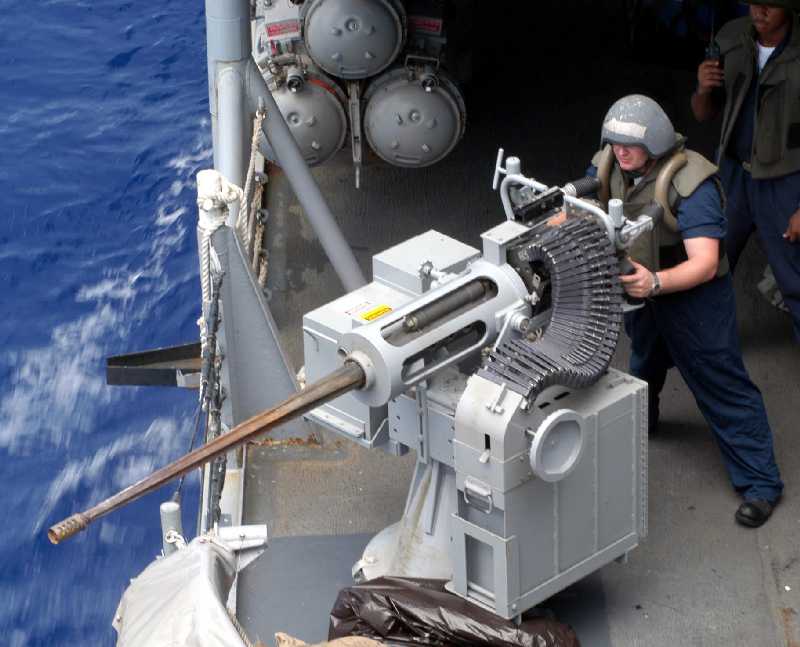
Also known as the "Bushmaster," this weapon is a navalized version of the "Chain Gun®," an externally-powered weapon developed by Hughes for the US Army as the Mark 242. The name "Chain Gun" derives from the use of a loop of roller chain to drive the bolt back and forth. A single electric motor, located in the receiver group, powers all moving parts for the ammunition feeding, loading, firing, extraction and cartridge ejection operations. The weapon can be fired in both the single-shot mode and in automatic mode.
This gun had a long road to travel to gain acceptance onto USN ships. In 1977 the Chief of Naval Operations (CNO) approved their use to replace aging 20 mm Mark 16 guns, which were difficult to maintain and did not use standard NATO ammunition. However, the gun was not operationally evaluated for naval use until the summer of 1987. Then, with the urgent need for such weapons in the Persian Gulf, production of this weapon was greatly accelerated. Much of the necessary work was done at Naval Weapons Support Center Crane which was responsible for the design of the Mark 88 mounting.
The Mark 38 Machine Gun System (MGS) denotes the Mark 242 when mounted on the Mark 88 Single Mounting. The Mark 38 MGS was employed aboard various combatant and auxiliary ships in the Mid-East Force escort operations and during Operations Desert Shield and Desert Storm. The weapons are maintained in a rotatable pool, available for temporary installation on various deploying ships and permanent installation on certain amphibious and auxiliary ships, patrol craft and Coast Guard cutters. In the event of a major malfunction, the gun can be removed from the mount and another one installed in its place in five minutes by two people.
As the Mark 88 is manually trained and lacks stabilization, target tracking is difficult when the MGS is used on a small combatant ship. For this reason, the Navy started a program to develop a low-cost, remotely controlled and stabilized version designated as the Mark 38 Mod 2. Improvements compared to the Mark 38 include an on-mount electro-optical sight, improved ammunition loading, improved man/machine interface, an embedded trainer and ship roll compensation. The new system also provides the capability to have two different ammunition types loaded and selecting between them from the remote console. The remote operator console is a 12-inch (30.5 cm) color LCD equipped with 12 soft keys. The picture on the computer screen is extremely clear, displaying a real-time, 360-degree, 7,000 - 8,000 yard (6,400 - 7,300 m) picture. In 2003, successful testing was conducted aboard the USS Decatur (DDG-73) and USS Howard (DDG-83). USS Princeton (CG-59) was the first ship to have this weapon system permanently installed. Tests on Princeton demonstrated a very robust capability during day and night tracking and firing on a high speed maneuvering surface target (HSMST). During the live fire against the HSMST, the system gained a kill of the target at more than twice the range of the current Mod 1 gun. Other tests have shown a two to three fold increase in Probability of Hit (POH) versus the Mod 1.
In 2004, United Defense received a $395.5 million contract to produce the Mark 38 Mod 2 weapon system. The contract runs through 2010 with the first eight units and spares to be delivered in 2004, 13 in 2005 and 67 in 2006.
The Mark 96 Mod 0 is a two-axis stabilized mounting that contains both a 25 mm M242 chain gun and a 40 mm Mark 19 grenade machine gun. The system combines elements from the Mark 3 Mod 9 and Mark 38 gun mounts to provide a lightweight, low-cost solution to small-caliber gun requirements including a "man-in-the-loop" system for low-intensity combat situations. The operator sits on the mount, which moves to compensate for the pitch and roll of the ship.
Rheinmetall AG has also adapted the M242 for a naval mounting designated as MLG 25.
The USN purchased a total of 243 guns between FY1986 and FY1992.
The Mark 38 Mod 3 is a new development program which has an updated multi-function display (MFD) and a new Control Console. Besides the 25 mm Bushmaster, an option for mounting a coaxial 7.62mm chain gun is available.
| Designation | 25 mm/87 (1") Mark 38 Machine Gun System
Mountings: Mark 88, Mark 96, Mark 38 Mod 2, Mark 38 Mod 3 |
|---|---|
| First Ship Class Used On | Mark 88: N/A
Mark 38 Mod 2: Princeton CG-59 Mark 96: Cyclone PC-1 |
| Date Of Design | 1972 (Army version)
1987 (Naval version) |
| Date In Service | 1988 (Naval version) |
| Gun Weight | 240 lbs. (109 kg) |
| Gun Length oa | 105.2 in (2.672 m) |
| Bore Length | 85.6 in (2.175 m) |
| Rifling Length | N/A |
| Grooves | N/A |
| Lands | N/A |
| Twist | N/A |
| Chamber Volume | N/A |
| Rate Of Fire | 175 - 200 rounds per minute cyclic |
| Type | Fixed |
|---|---|
| Weight of Complete Round | 1.1 lbs. (0.5 kg) |
| Projectile Types and Weights | APDS, APDS-T:
0.295 lbs. (0.134 kg) (w/Sabot) 0.225 lbs. (0.102 kg) (Penetrator) HEI, HEI-T: 0.406 lbs. (0.184 kg) SAPHEI, SAPHEI-T: N/A FAPDS-T: N/A |
| Bursting Charge | N/A |
| Projectile Length | N/A |
| Propellant Charge | 2.9 oz (0.08 kg) |
| Cartridge | 25 x 137 mm |
| Muzzle Velocity | APDS, APDS-T: 4,410 fps (1,345 mps)
HEI, HEI-T: 3,610 fps (1,100 mps) |
| Working Pressure | N/A |
| Approximate Barrel Life 1 | 25,000 rounds |
| Ammunition stowage per gun 2 | See Note 2 |
- ^The Receiver life is 25,000 rounds and the barrel is replaced whenever it fails a wear test, usually around the same time.
- ^Ammunition for the Mark 38 in the Mark 88 mounting is in 150 linked cartridges. The Mark 96 mounting has 400 rounds for the M242 cannon and 96 rounds for the Mark 19 grenade launcher on mount. The MLG 25 mounting has 220 rounds in linked cartridges. The Mark 38 Mod 3 has 168 ready rounds on mount plus 750 rounds for the optional 7.62-mm coax chain gun.
- Time of Flight:
APDS-T: 3,300 yards (3,000 m): 3.0 seconds
HEI-T: 2,200 yards (2,000 m): 3.3 seconds
| Elevation | Range |
|---|---|
| Effective Range | 2,700 yards (2,457 m) |
| Maximum Range | 7,450 yards (6,800 m) |
| Designation | Non-stabilized Mount: Mark 38 MGS (using Mark 88 mounting)
Stabilized Mounts: Mark 38 Mod 2 and Mod 3 Stabilized Mount with Grenade Launcher: Mark 96 Rheinmetall MLG 25 |
|---|---|
| Weight | Mark 38 MGS: 1,250 lbs. (567 kg)
Mark 38 Mod 2: N/A Mark 38 Mod 3: 2,300 lbs. (1,042 kg) Mark 96: N/A MLG 25: 1,984 lbs. (900 kg) including 220 rounds of ammunition |
| Elevation | Mark 88: -20 / +55 degrees
Others: N/A |
| Rate of Elevation | Manual operation, only
Mark 38 Mod 2: N/A |
| Train | 360 degrees |
| Rate of Train | Manual operation, only
Mark 38 Mod 2: N/A |
| Gun Recoil | N/A |
The Mark 96 penetrates the deck for one electrical cable connection and is stabilized in train and elevation using three gyros.


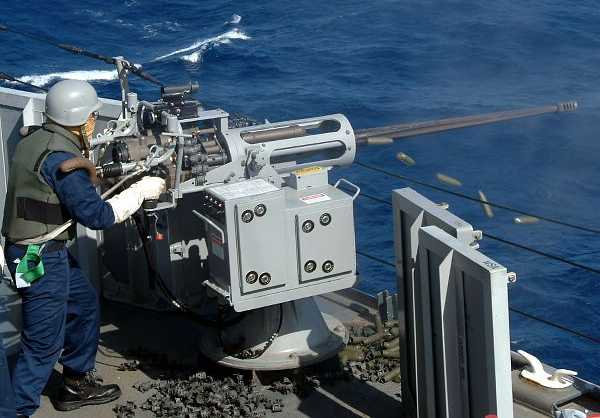
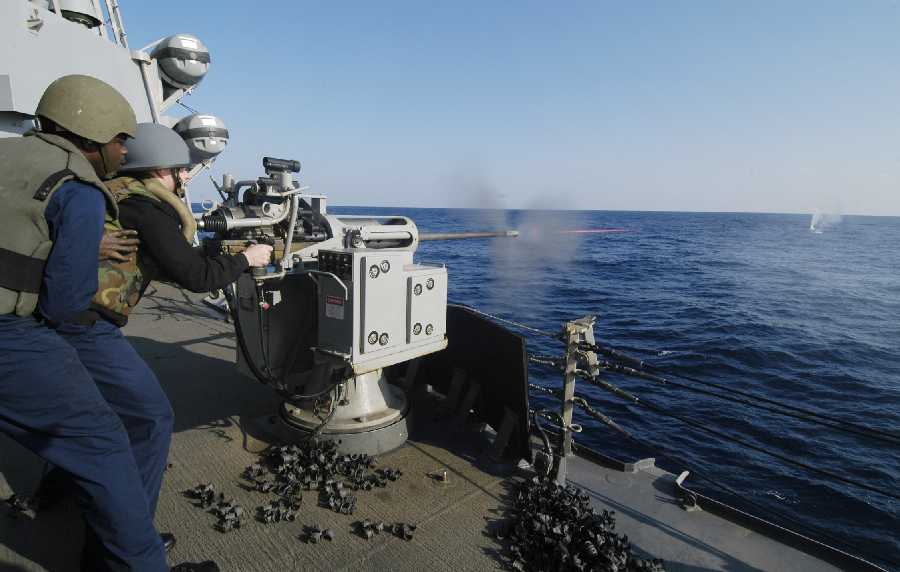

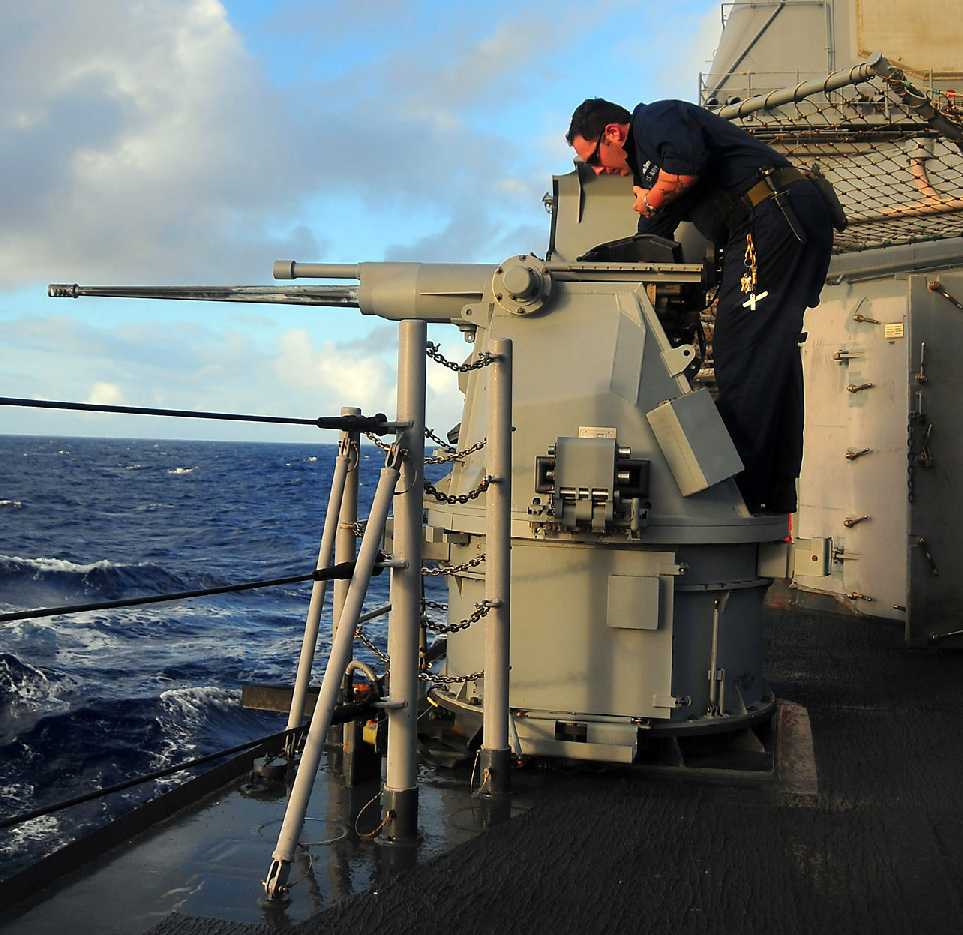
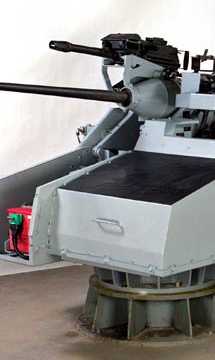


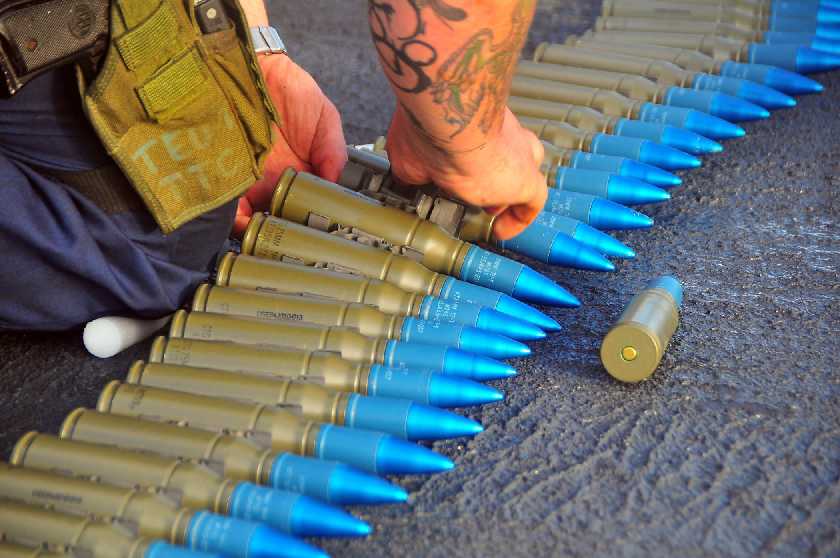
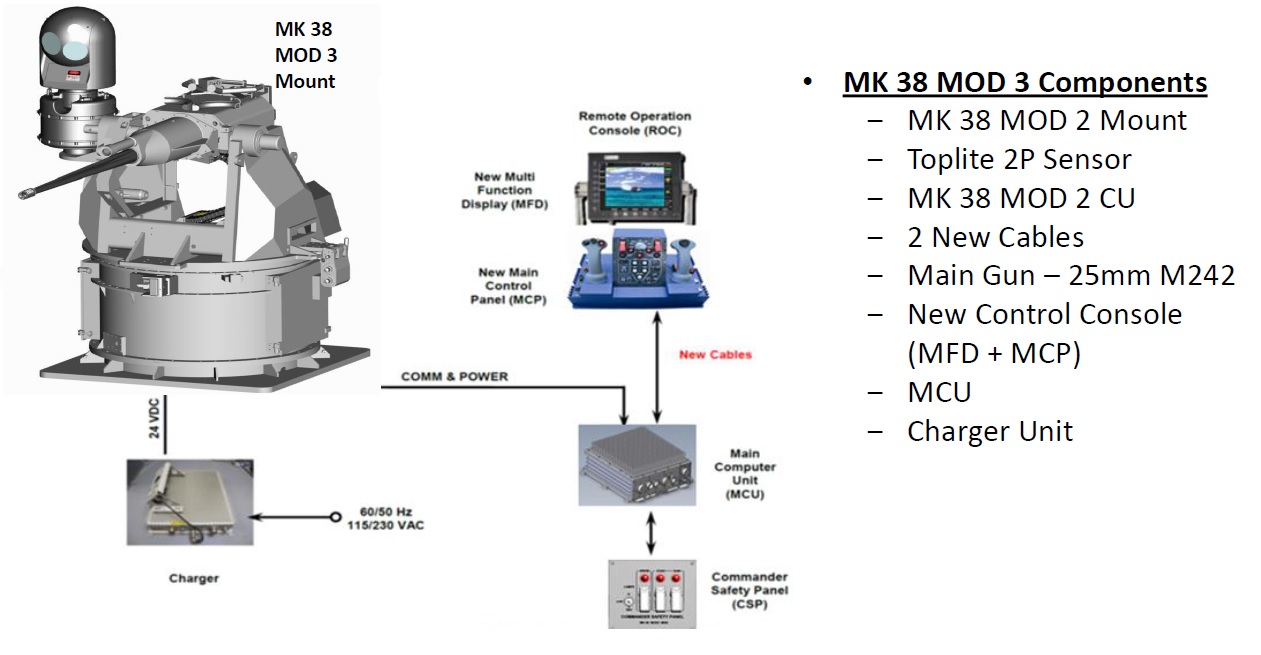
"The Naval Institute Guide to World Naval Weapon Systems 1991/1992" and "1994 Update" both by Norman Friedman
---
"25mm MK38 MOD 3 Machine Gun System Qualification Status (19444)" a presentation by Mr. Jim McConkie, NSWC Dahlgren at NDIA 2017 Armament Systems Forum & Firing Demonstration
---
BAE Systems Press Releases
Rheinmetall AG Press Releases
Surface Force (SURFOR) Press Releases
United Defense Press Releases
US Navy Fact File
08 November 2006 - Benchmark
16 February 2009 - Added pictures of Mark 38 Mod 2 and training ammunition aboard USS Lake Champlain CG-57
14 June 2014 - Added comment about 7.62 mm coax
05 August 2016 - Converted to HTML 5 format
10 July 2017 - Added notes and image of Mark 38 Mod 3
06 June 2018 - Reorganized notes
11 April 2019 - Added projectile information
